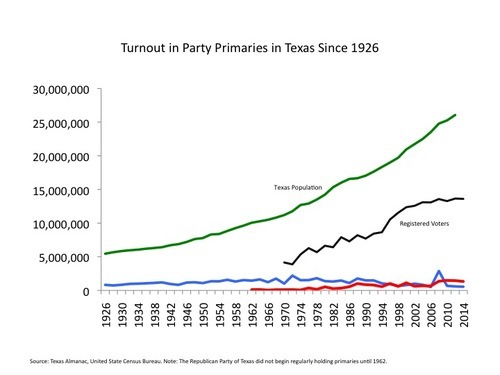
- The graph is pulled from TexasRedistricting.
The Texas Observer makes the following point:
The Texas Observer makes the following point:
The blue and red lines represent the number of votes in the Democratic and Republican primaries, respectively. The green line is Texas’ population, and black is the number of registered voters.
One reason people might be less inclined to vote in primary elections these days is that the general election would seem to matter more than it used to in the state. The Republican Party barely existed in 1926—that was year the GOP held its first statewide primary—and the general election was a rubber stamp that confirmed the results of the Democratic primary.
But for all practical purposes, Republicans have the same level of dominance in statewide offices that Democrats had in their period of one-party control. For the better part of two decades, the Republican primary has been the only election that really matters. Yet even within the GOP, primary turnout is remarkably low.
"Indeed, for all the talk of Texas being a “red state,” recent Republican primary turnout has been no better in aggregate numbers than Democratic turnout in the 1940s and 50s (and lower as a percentage of the population).
And in only 8 out of 27 Republican primaries since 1962 – the year Texas Republicans began having regular primaries – has the turnout exceeded turnout in the 1926 Democratic primary."
Much of what’s happened to the state Republican Party in recent years is down to the simple fact that the average Texan has become less likely to vote in the GOP primary. It’s a fundamentally undemocratic situation that gives power brokers and small interest groups enormous leverage on the whole state government. And it seems unlikely to change any time soon.